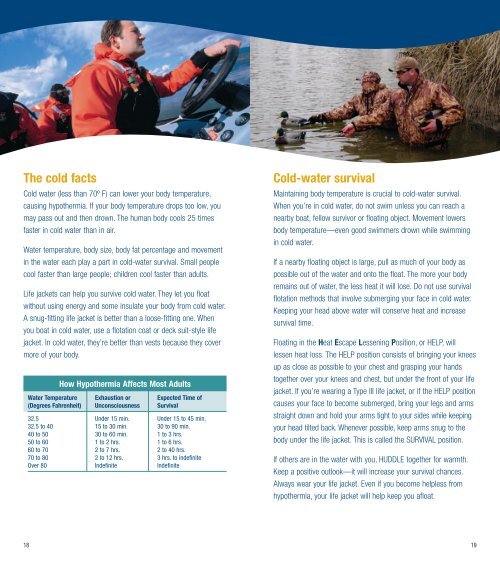Facts About Life Jackets
Facts About Life Jackets
Facts About Life Jackets
You also want an ePaper? Increase the reach of your titles
YUMPU automatically turns print PDFs into web optimized ePapers that Google loves.
The cold facts<br />
Cold water (less than 70º F) can lower your body temperature,<br />
causing hypothermia. If your body temperature drops too low, you<br />
may pass out and then drown. The human body cools 25 times<br />
faster in cold water than in air.<br />
Water temperature, body size, body fat percentage and movement<br />
in the water each play a part in cold-water survival. Small people<br />
cool faster than large people; children cool faster than adults.<br />
<strong>Life</strong> jackets can help you survive cold water. They let you float<br />
without using energy and some insulate your body from cold water.<br />
A snug-fitting life jacket is better than a loose-fitting one. When<br />
you boat in cold water, use a flotation coat or deck suit-style life<br />
jacket. In cold water, they’re better than vests because they cover<br />
more of your body.<br />
How Hypothermia Affects Most Adults<br />
Water Temperature Exhaustion or Expected Time of<br />
(Degrees Fahrenheit) Unconsciousness Survival<br />
32.5 Under 15 min. Under 15 to 45 min.<br />
32.5 to 40 15 to 30 min. 30 to 90 min.<br />
40 to 50 30 to 60 min. 1 to 3 hrs.<br />
50 to 60 1 to 2 hrs. 1 to 6 hrs.<br />
60 to 70 2 to 7 hrs. 2 to 40 hrs.<br />
70 to 80 2 to 12 hrs. 3 hrs. to indefinite<br />
Over 80 Indefinite Indefinite<br />
18<br />
Cold-water survival<br />
Maintaining body temperature is crucial to cold-water survival.<br />
When you’re in cold water, do not swim unless you can reach a<br />
nearby boat, fellow survivor or floating object. Movement lowers<br />
body temperature—even good swimmers drown while swimming<br />
in cold water.<br />
If a nearby floating object is large, pull as much of your body as<br />
possible out of the water and onto the float. The more your body<br />
remains out of water, the less heat it will lose. Do not use survival<br />
flotation methods that involve submerging your face in cold water.<br />
Keeping your head above water will conserve heat and increase<br />
survival time.<br />
Floating in the Heat Escape Lessening Position, or HELP, will<br />
lessen heat loss. The HELP position consists of bringing your knees<br />
up as close as possible to your chest and grasping your hands<br />
together over your knees and chest, but under the front of your life<br />
jacket. If you’re wearing a Type III life jacket, or if the HELP position<br />
causes your face to become submerged, bring your legs and arms<br />
straight down and hold your arms tight to your sides while keeping<br />
your head tilted back. Whenever possible, keep arms snug to the<br />
body under the life jacket. This is called the SURVIVAL position.<br />
If others are in the water with you, HUDDLE together for warmth.<br />
Keep a positive outlook—it will increase your survival chances.<br />
Always wear your life jacket. Even if you become helpless from<br />
hypothermia, your life jacket will help keep you afloat.<br />
19


